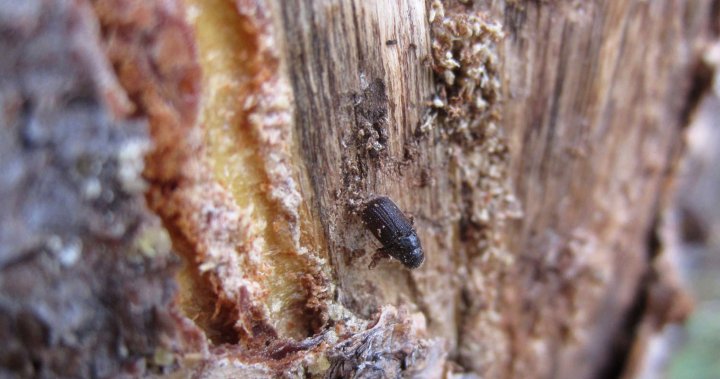A tiny pest leaving behind a graveyard of trees across Canadian forests may have helped stoke some of the conditions for the devastating fire in Jasper, but the biggest drivers were heat and dryness, climate and forest scientists say.
“So much of the forest had been impacted by mountain pine beetle outbreak, and we had those dead fuels accumulated and then down on the ground contributing to the intensity of the fire,” said Lori Daniels, a professor in the University of British Columbia’s department of forest and conservation sciences.
The mountain pine beetle has ravaged pine trees across Alberta and British Columbia for the past two decades, boring into bark, drying out needles, and transforming swaths of wilderness from green to rust.

More than 18 million hectares of Canadian forests have been affected “to some degree,” according to Natural Resources Canada.
“They kind of look like pickup sticks in the forest. They’re very flammable in these hot, dry summers,” said Daniels, who has studied the history of Jasper National Park.
Breaking news from Canada and around the world
sent to your email, as it happens.

Get breaking National news
For news impacting Canada and around the world, sign up for breaking news alerts delivered directly to you when they happen.
The mountain pine beetle population dropped after last year’s particularly cold winter in Alberta, but began to rebound in recently warmer temperatures, says Chris Bone, a geography professor at the University of Victoria, who has researched the pine beetle extensively.

“With climate change (and) warmer conditions, their populations increase, and up goes tree mortality,” Bone said in an interview with Global News.
The fire in Jasper spread with lightning speed and destroyed 30 per cent of the townsite, including more than 300 buildings.
Parks Canada has faced questions about whether it could have done more to prevent the fire’s explosive spread, including mitigating the effects of the mountain pine beetle.

The federal agency says since 1996 it has spent hundreds of millions of dollars fighting the insect, including carrying out “prescribed burns.”
“Pine beetle is through hundreds of thousands of hectares of forest. Short of bulldozing all of that or burning all of it, or mechanically removing all of it, we work to minimize risk,” Parks Canada president and CEO Ron Hallman said at a news conference Monday.
“There is nothing any human on earth or any piece of equipment could have done standing in front of that wall of fire that would have allowed them to stop it.”
Environment and Climate Change Minister Steven Guilbeault also defended the federal government’s fire prevention efforts.
“To think that over all those decades, we would not have deployed all of the resources necessary to try and do everything that is humanly possible to protect a town from a forest fire is simply, simply not true.”
Bone says he is not “convinced” Parks Canada could have done much to slow the fire down.
“Mountain pine beetle has definitely contributed to the increase in wildfires over the years. However, I think that picture gets muddied a lot now given how hot and how dry conditions are becoming,” he said.
“If you were to ask that question 15 years ago, I think you’d probably get a different response…. Climate is such a main driver of these fires right now, whether they’re occurring in mountain pine beetle areas or not.”
— with files from Mackenzie Gray and Jillian Piper
© 2024 Global News, a division of Corus Entertainment Inc.





